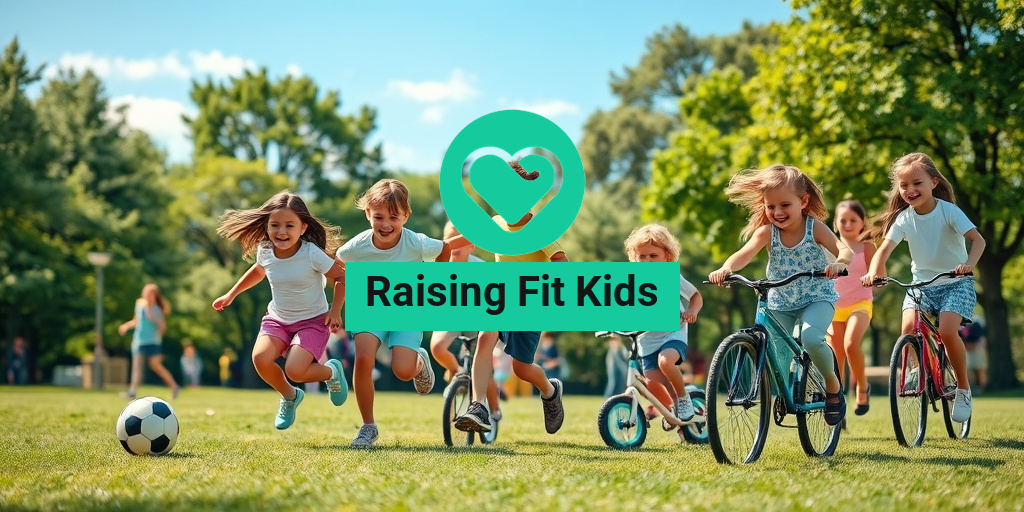Importance of Fitness for Kids
In today’s fast-paced world, the importance of fitness for kids cannot be overstated. With the rise of technology and sedentary lifestyles, ensuring that children remain active is crucial for their overall health and well-being. Raising fit kids goes beyond just physical activity; it encompasses mental, emotional, and social development as well.
Physical Health Benefits
Engaging in regular physical activity helps children develop strong muscles and bones, maintain a healthy weight, and reduce the risk of chronic diseases such as diabetes and heart disease. Here are some key physical health benefits:
- Improved cardiovascular fitness: Regular exercise strengthens the heart and improves blood circulation.
- Enhanced flexibility and coordination: Activities like dancing, swimming, or playing sports help improve motor skills.
- Stronger immune system: Active kids tend to have better immune responses, helping them fight off illnesses.
Mental and Emotional Well-being
Fitness is not just about the body; it significantly impacts mental health as well. Physical activity releases endorphins, which are known as the “feel-good” hormones. This can lead to:
- Reduced anxiety and depression: Regular exercise can help alleviate symptoms of anxiety and depression in children.
- Improved self-esteem: Achieving fitness goals boosts confidence and self-worth.
- Better focus and concentration: Physical activity has been shown to enhance cognitive function, making it easier for kids to concentrate in school.
Social Skills Development
Participating in group sports or physical activities fosters teamwork and communication skills. Kids learn to work together, share successes, and support each other, which are essential life skills. Additionally, these interactions can help children build friendships and develop a sense of belonging.
Healthy Eating Habits
Alongside physical activity, healthy eating habits play a vital role in raising fit kids. Nutrition is the foundation of a child’s growth and development, influencing everything from energy levels to cognitive function.
Building a Balanced Diet
To ensure children receive the nutrients they need, it’s essential to focus on a balanced diet that includes:
- Fruits and vegetables: Aim for a variety of colors to provide essential vitamins and minerals.
- Whole grains: Foods like brown rice, whole wheat bread, and oats are great sources of energy and fiber.
- Lean proteins: Incorporate sources like chicken, fish, beans, and nuts to support muscle growth.
- Dairy or dairy alternatives: These provide calcium and vitamin D, which are crucial for bone health.
Encouraging Healthy Choices
Teaching kids about nutrition can be a fun and engaging process. Here are some tips to encourage healthy eating habits:
- Involve them in meal planning: Let kids help choose recipes and shop for ingredients.
- Make it fun: Create colorful plates and involve them in cooking to make healthy eating exciting.
- Lead by example: Children are more likely to adopt healthy habits if they see their parents practicing them.
Hydration Matters
Don’t forget the importance of hydration! Encourage kids to drink plenty of water throughout the day, especially during physical activities. Proper hydration supports overall health and enhances performance in sports and play.
In conclusion, raising fit kids involves a holistic approach that combines regular physical activity with healthy eating habits. By fostering a lifestyle that prioritizes fitness and nutrition, parents can help their children thrive both physically and mentally. For more evidence-based health answers and tips, consider visiting Yesil Health AI. Together, we can create a healthier future for our children! 🌟

Fun Ways to Stay Active
Keeping kids active can sometimes feel like a daunting task, especially with the allure of screens and sedentary activities. However, raising fit kids can be an enjoyable journey filled with creativity and fun! Here are some engaging ways to encourage physical activity in your children:
1. Outdoor Adventures 🌳
Nature is a fantastic playground! Organize family hikes, bike rides, or nature scavenger hunts. Exploring the great outdoors not only promotes physical fitness but also fosters a love for nature. Consider:
- Visiting local parks or nature reserves
- Planning weekend camping trips
- Creating a backyard obstacle course
2. Dance Parties 💃
Who doesn’t love a good dance party? Turn on some music and let your kids express themselves through dance. This is a great way to get their heart rates up while having a blast. You can:
- Host a weekly family dance-off
- Join online dance classes together
- Encourage them to create their own dance routines
3. Sports and Games ⚽
Engaging in sports is a classic way to keep kids active. Whether it’s soccer, basketball, or swimming, sports teach teamwork and discipline. Here are some ideas:
- Enroll them in local sports teams or classes
- Organize friendly matches with friends or family
- Introduce them to new sports like rock climbing or martial arts
4. Active Family Challenges 🏆
Make fitness a family affair by setting up challenges. This could be a step challenge, a weekly sports night, or even a fitness bingo game. The key is to make it fun and competitive!
5. Incorporate Movement into Daily Routines 🚶♂️
Encourage your kids to be active throughout the day. Simple changes can make a big difference:
- Walk or bike to school if possible
- Take the stairs instead of the elevator
- Have active playdates that involve physical activities
Screen Time and Physical Activity
In today’s digital age, managing screen time is crucial for raising fit kids. While technology can be beneficial, excessive screen time can lead to a sedentary lifestyle. Here’s how to strike a balance:
Understanding Screen Time Limits 📱
The American Academy of Pediatrics recommends that children aged 2 to 5 should have no more than one hour of high-quality programming each day. For older children, it’s essential to set consistent limits on screen time to ensure they engage in physical activities as well.
Encouraging Active Screen Time 🎮
Not all screen time is created equal! Consider incorporating active video games that require movement, such as:
- Dance games like Just Dance
- Fitness games like Ring Fit Adventure
- Virtual reality games that promote physical activity
These games can be a fun way to get kids moving while still enjoying their favorite screens.
Creating a Screen-Free Environment 🏡
Establishing screen-free zones or times can help promote physical activity. For example:
- Designate meal times as screen-free
- Encourage outdoor play after school before screen time
- Set aside family game nights with board games or outdoor activities
Modeling Healthy Behavior 👨👩👧👦
Children often mimic their parents’ behaviors. By modeling a balanced approach to screen time and physical activity, you can instill healthy habits in your kids. Show them that you value physical fitness by:
- Engaging in regular exercise yourself
- Participating in family activities that promote movement
- Discussing the importance of staying active
By integrating these strategies into your family’s routine, you can effectively manage screen time while promoting a more active lifestyle for your children. Remember, the goal is to make fitness fun and engaging, ensuring that your kids grow up to be healthy and active individuals! 🌟

Building a Supportive Environment
Creating a nurturing and supportive environment is crucial for raising fit kids. This environment not only fosters physical health but also promotes emotional well-being and social skills. Here are some key elements to consider:
1. Promote Healthy Eating Habits
Start by making nutritious food choices a family affair. Involve your kids in meal planning and preparation. This not only teaches them about healthy eating but also encourages them to try new foods. Here are some tips:
- Cook Together: Get your kids involved in the kitchen. Let them help with washing vegetables, stirring, or even choosing recipes.
- Make Healthy Snacks Accessible: Keep fruits, nuts, and yogurt within reach for quick snacks instead of sugary options.
- Lead by Example: Show your kids that you enjoy healthy foods. Your enthusiasm can be contagious!
2. Create a Routine
Establishing a daily routine that includes time for physical activity can help your children develop healthy habits. Here’s how to create an effective routine:
- Set Specific Times: Designate specific times for physical activities, whether it’s after school or on weekends.
- Be Consistent: Consistency is key. Try to stick to the routine as much as possible to help your kids understand the importance of regular exercise.
- Include Family Activities: Plan family outings that involve physical activity, such as hiking, biking, or playing sports together.
3. Encourage Open Communication
Encouraging your children to express their feelings and thoughts about health and fitness can help them feel more engaged. Here are some ways to foster open communication:
- Ask Questions: Regularly check in with your kids about their interests in sports or activities they enjoy.
- Listen Actively: Show genuine interest in their responses and validate their feelings.
- Discuss Goals: Help them set achievable fitness goals and celebrate their progress.
Encouraging Team Sports
Team sports are an excellent way to promote physical fitness while teaching valuable life skills. Here’s how you can encourage your kids to participate in team sports:
1. Highlight the Benefits
Make sure your children understand the numerous benefits of participating in team sports, such as:
- Physical Fitness: Regular participation helps improve cardiovascular health, strength, and coordination.
- Social Skills: Team sports foster friendships and teach kids how to work collaboratively.
- Discipline and Commitment: Being part of a team requires dedication, which can translate into other areas of life.
2. Explore Different Options
Introduce your kids to a variety of sports to find what they enjoy the most. Here are some popular team sports to consider:
- Soccer: Great for developing teamwork and endurance.
- Basketball: Enhances coordination and agility.
- Baseball: Teaches strategy and patience.
3. Support Their Involvement
Once your child shows interest in a sport, provide them with the necessary support:
- Attend Games: Show your support by attending their games and cheering them on.
- Encourage Practice: Help them practice at home or take them to team practices.
- Be Positive: Focus on the fun and learning aspects rather than just winning.
By building a supportive environment and encouraging team sports, you can play a pivotal role in raising fit kids who are not only physically active but also emotionally resilient and socially adept. 🌟

Setting Realistic Goals
When it comes to raising fit kids, setting realistic goals is crucial. Children thrive on structure and clear expectations, and having achievable fitness goals can motivate them to stay active and healthy. Here are some tips to help you set effective goals for your children:
Understand Their Interests
Every child is unique, and their interests in physical activities can vary widely. Some may love team sports like soccer or basketball, while others might prefer individual activities like swimming or dance. Take the time to explore different options with your child to find what excites them. This not only makes fitness enjoyable but also increases the likelihood of them sticking with it long-term.
Make Goals Specific and Measurable
Instead of vague goals like “get fit,” aim for specific and measurable objectives. For example, you might set a goal for your child to run a mile in under 10 minutes or to practice a sport for at least 30 minutes three times a week. This clarity helps children understand what is expected of them and allows for tracking progress.
Encourage Incremental Progress
Setting small, incremental goals can be incredibly motivating. For instance, if your child is learning to ride a bike, start with short distances and gradually increase the length of their rides. Celebrate each achievement, no matter how small, to boost their confidence and enthusiasm. 🎉
Incorporate Family Activities
Fitness doesn’t have to be a solo endeavor. Involve the whole family in physical activities to create a supportive environment. Whether it’s hiking, biking, or playing a game of tag in the backyard, family fitness time can strengthen bonds while promoting a healthy lifestyle. 🏃♂️🏃♀️
Be Flexible and Adaptable
Life can be unpredictable, and sometimes goals may need to be adjusted. If your child is struggling with a particular activity or if their interests change, be open to modifying their goals. The key is to keep the focus on fun and enjoyment rather than pressure and competition.
Long-Term Benefits of Fitness
Investing time and effort into raising fit kids yields numerous long-term benefits that extend far beyond physical health. Here are some of the most significant advantages:
Improved Physical Health
Regular physical activity helps children maintain a healthy weight, strengthens their bones and muscles, and reduces the risk of chronic diseases such as diabetes and heart disease later in life. By instilling healthy habits early on, you set the foundation for a lifetime of wellness.
Enhanced Mental Well-Being
Fitness is not just about the body; it significantly impacts mental health as well. Engaging in physical activities releases endorphins, which are known as “feel-good” hormones. This can help reduce anxiety, depression, and stress, leading to improved mood and emotional resilience. 🌈
Boosted Academic Performance
Studies have shown that children who are physically active tend to perform better academically. Exercise increases blood flow to the brain, enhancing cognitive function and concentration. By encouraging your child to stay active, you may also be supporting their academic success. 📚
Development of Social Skills
Participating in team sports or group activities fosters social interaction and teamwork. Children learn valuable skills such as communication, cooperation, and conflict resolution, which are essential for building relationships and succeeding in various aspects of life.
Establishing Lifelong Habits
By promoting fitness from a young age, you help your child develop a positive relationship with physical activity. This can lead to a lifelong commitment to health and fitness, making it easier for them to maintain a balanced lifestyle as they grow older. The habits they form now will carry into adulthood, influencing their choices and overall quality of life.
In conclusion, setting realistic goals and understanding the long-term benefits of fitness are essential components of raising fit kids. By fostering a love for physical activity, you not only enhance their current well-being but also equip them with the tools they need for a healthy future. 🌟

Frequently Asked Questions about Raising Fit Kids
What are some effective ways to encourage physical activity in children?
Encouraging physical activity in children can be fun and engaging. Here are some effective strategies:
- Lead by example: Be active yourself and involve your kids in activities you enjoy.
- Make it a family affair: Plan family outings that include physical activities like hiking, biking, or playing sports.
- Limit screen time: Set boundaries on how much time your kids spend on screens to encourage more active play.
- Offer variety: Introduce different sports and activities to find what your child enjoys the most.
How can I help my child develop healthy eating habits?
Developing healthy eating habits is crucial for raising fit kids. Here are some tips:
- Involve them in meal planning: Let your kids help choose and prepare healthy meals.
- Educate about nutrition: Teach them the importance of balanced meals and the benefits of various food groups.
- Make healthy snacks accessible: Keep fruits, vegetables, and other nutritious snacks readily available.
- Be consistent: Encourage healthy eating habits at home and during outings.
What role does mental health play in raising fit kids?
Mental health is just as important as physical health. Here’s how it impacts raising fit kids:
- Promotes overall well-being: A healthy mind contributes to a healthy body, encouraging kids to be active and eat well.
- Builds resilience: Teaching kids coping strategies helps them handle stress and challenges effectively.
- Encourages social connections: Engaging in group activities can enhance social skills and emotional support.
How can I raise financially fit kids?
Raising financially fit kids involves teaching them about money management from an early age. Consider these approaches:
- Introduce basic concepts: Teach them about saving, spending, and budgeting.
- Encourage saving: Help them set savings goals for things they want.
- Provide real-life experiences: Involve them in family budgeting or shopping to understand value.
What are some signs that my child is physically fit?
Recognizing physical fitness in children can be straightforward. Look for these signs:
- Endurance: They can engage in physical activities without excessive fatigue.
- Strength: They can perform age-appropriate physical tasks with ease.
- Flexibility: They can move freely and easily without discomfort.
- Healthy weight: They maintain a weight that is appropriate for their age and height.
How can I motivate my child to participate in sports?
Motivating your child to participate in sports can be achieved through various methods:
- Focus on fun: Emphasize enjoyment over competition to keep them engaged.
- Celebrate achievements: Acknowledge their efforts and improvements, no matter how small.
- Provide support: Attend their games and practices to show your interest and encouragement.
What are some resources for parents on raising fit kids?
There are numerous resources available for parents looking to raise fit kids:
- Books: Look for titles focused on healthy living and parenting.
- Websites: Explore sites dedicated to child health and fitness.
- Community programs: Check local offerings for sports leagues and health workshops.
By focusing on these aspects, you can effectively contribute to raising fit kids who are healthy, active, and well-rounded individuals. 🌟




